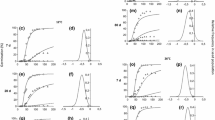Abstract
Since the observations of those regularly handling Norway spruce [Picea abies (L.) Karst.] seeds with regard to their imbibition frequently disagree with earlier opinions that this process is markedly inhibited by the seed coat, we decided to examine the morphological factors influencing imbibition in seeds of different colour and different provenances. The seed coat, consisting of the sarcotesta, sclerotesta and endotesta, was found to have little influence on the passage of water, despite the presence of sclereids full of wax lamellae. No differences in seed coat structure were observed between provenances or colours of seeds. The cells of the endotesta were lignified in the area of the micropyle, however, and stood out lip-like on the outer surface of the micropyle after imbibition. An opening in the sclerotesta filled with parenchyma cells was also seen at the chalazal end of the seed. Neither of these openings, which were covered by accumulations of wax, served as the main route for the passage of water, though the micropyle opened up slightly after only 24 h incubation, when the lignified cells bordering it swelled differently from the rest of the endotesta. The progress of water into the seed soon discontinued, however, as the tip of the nucellar cap, covered with wax and crystals, effectively plugged the micropyle. This opening of the micropyle may be the reason why the IDS method does not always succeed in separating viable from non-viable spruce seeds sufficiently well by their density. Imbibition was mostly regulated by the lipophilic layers surrounding the endosperm, which are mainly of nucellar origin, and particularly the megaspore membranes, the outer and inner exine. Imbibition was further hampered by the impermeable nucellar cap, which covered about 3/4 of the length of the endosperm and had merged with the outer exine at its edges. Deposits of wax were observed both between the exines and between the endotesta and the nucellar layers at the edges of the nucellar cap. Waxes may serve as a defence against diseases at the sites of water penetration, while simultaneously increasing the significance of the nucellar endosperm covers as regulators of imbibition.
Similar content being viewed by others
References
Bäck J, Huttunen S, Kristen U (1993) Carbohydrate distribution and cellular injuries in acid rain and cold-treated spruce needles. Trees 8: 75–84
Bergsten U (1987) Incubation of Pinus sylvestris L. and Picea abies L. (Karst.) seeds at controlled moisture content as an invigoration step in the IDS method. Dissertation. Swedish University of Agricultural Sciences. Department of Silviculture. Umeå
Coulter JM, Chamberlain CJ (1910) Morphology of gymnosperms. The University of Chicago Press, Chicago
Downie B, Wang BSP (1992) Upgrading germinability and vigour of jack pine, lodgepole pine, and white spruce by the IDS technique. Can J For Res 22: 1124–1131
Fahn A (1990) Plant anatomy. 4th edn. Pergamon Press, Oxford
Ferguson M (1904) Contributions to the life history of Pinus, with special reference to sporogenesis, the development of the gametophytes, and fertilization. Proc Wash Acad Sci 6: 1–202
Fink S (1991) Unusual pattern in the distribution of calcium oxalate in spruce needles and their possible relationship to the impact of pollutants. New Phytol 119: 41–51
Goo M (1951) Water absorption by tree seeds. Bull Tokyo Univ For 39: 55–60
Grzywacz AP, Rosochacka J (1980) The colour of Pinus sylvestris L. seed and their susceptibility to damping-off. II. Colour of seed coats and their chemical composition. Eur J For Pathol 10: 193–201
Hagner M (1985) Germinant morphology and seedling establishment in Picea abies. (in Swedish) Sver Skogsvårdsför Tidsk 1: 77–81
Håkansson A (1956) Seed development of Picea abies and Pinus silvestris. Medd Statens Skogsforskningsinst 46: 1–23
Hoff RJ (1987) Dormancy in Pinus monticola seed related to stratification time, seed coat and genetics. Can J For Res 17: 294–298
Humphrey CD, Pittman FE (1974) A simple methylene blue-azure II-basic fuchsin stain for epoxy-embedded tissue section. Stain Technol 49: 9–14
ISTA (1985) International seed testing rules for seed testing 1985. Seed Sci Technol 18: 337–343
Jensen WA (1962) Botanical histochemistry. Principles and practice. Freeman, San Francisco
Kamra SK (1967) Comparative studies on the germination of Scots pine and Norway spruce seed under different temperatures and photoperiods. Stud For Suec 51: 1–16
Kujala V (1927) Untersuchungen über den Bau und Keimfähigkeit von Kiefern- und Fichtensamen in Finnland. Comm Inst Quaest For Finlandiae 12: 1–68
Leinonen K, Nygren M, Rita H (1993) Temperature control of germination in the seeds of Picea abies L. Karst. Scand J For Res 8: 107–117
von Lürzer E (1956) Megasporenmembranen bei einigen Cupressaceen. Grana Palynol 1: 70–78
Nobbe F (1876) Handbuch der Samenkunde. Wiegandt, Hempel and Paren, Berlin
Sarvas R (1962) Investigations on the flowering and seed crop of Pinus sylvestris. Commun Inst For Fenn 53: 1–198
Sarvas R (1964) Conifers [Harupunt] (in Finnish) WSOY, Porvoo
Schnarf K (1933) Embryologie der Gymnospermen. Handbuch der Pflanzenanatomie. X/2. Borntraeger, Berlin
Schnarf K (1937) Anatomie der Gymnospermen-Samen. Handbuch der Pflanzenanatomie. X/I. Borntraeger, Berlin
Singh H (1978) Embryology of gymnosperms. Encyclopedia of plant anatomy, X/2. Borntraeger, Berlin
Thomson RB (1905) The megaspore membrane of the gymnosperms. Univ Toronto Stud Biol Ser 4: 85–146
Tillman-Sutela E, Kauppi A (1995) The morphological background to imbibition in seeds of Pinus sylvestris L. of different provenances. Trees 9: 123–133
Voroshilova GI (1983) Formation of the wing in conifer seeds. (in Russian) Biol Nauki (Moscow) 8: 81–84
Zentsch W (1960) Zur Wasseraufnahme keimender Koniferensamen. Naturwissenschaften 47: 70
Zentsch W (1962) Zur Wasseraufnahme keimender Fichtensamen [Picea abies (L.) Karst.]. Flora 152: 227–235
Author information
Authors and Affiliations
Rights and permissions
About this article
Cite this article
Tillman-Sutela, E., Kauppi, A. The significance of structure for imbibition in seeds of the Norway spruce, Picea abies (L.) Karst.. Trees 9, 269–278 (1995). https://doi.org/10.1007/BF00202017
Received:
Accepted:
Issue Date:
DOI: https://doi.org/10.1007/BF00202017




